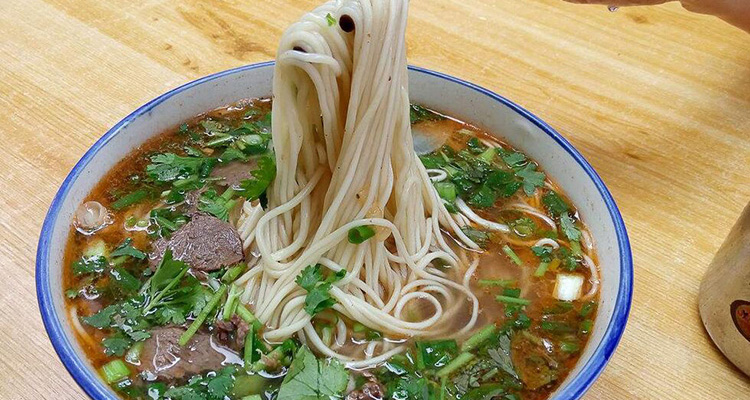Ulanhot Hand-Pulled Noodles: Grassland Flavor
Across the northern plains of China, Inner Mongolia’s cuisine carries the bold, warm spirit of the grasslands. In Ulanhot, the so-called “Red City,” a single bowl of hand-pulled noodles is more than a meal — it’s a living culinary performance, a comfort for the soul, and a regional treasure officially recognized as intangible cultural heritage. Let’s follow the journey from the chef’s hands to your bowl.
1. Origin and History: From Grassland Staples to Official Heritage
Ulanhot — meaning “red city” in Mongolian — sits in Xing’an League, where nomadic and agricultural traditions meet. The origins of Ulanhot pulled noodles trace back to Han settlers migrating northeast and exchanging culinary knowledge with local Mongolians. Settlers brought advanced noodle-making techniques from China’s Central Plains, while the grasslands provided high-quality beef and lamb for the broth. Initially a practical, filling dish for hardworking people, the noodle art was refined over generations. In 2018, the craft was added to Inner Mongolia’s intangible cultural heritage list, cementing its cultural importance.
2. Cultural Significance: Community, Memory, and Craft
In Ulanhot, a bowl of pulled noodles is woven into daily life. It wakes the city in the morning and comforts travelers at night. For migrants, it is a direct connection to home. Beyond taste, the noodle craft showcases Chinese culinary values: skill, patience, and precision. Watching a master pull noodles is like seeing a kinetic artwork — strength, rhythm, and technique come together in a few spectacular seconds.

3. Key Ingredients: Grassland Quality and Simple Goodness
Authentic Ulanhot pulled noodles rely on excellent, simple ingredients:
- Dough: High-gluten wheat flour from Ningxia or the Hetao region near Inner Mongolia gives the noodles their signature chewy texture. Water, a pinch of salt, and sometimes an alkaline agent are mixed to exact feel, then rested for elasticity.
- Broth: Beef or lamb bones from free-range animals grazed on the Horqin grasslands are simmered for hours to extract a clean, rich flavor. The broth may be clear or slightly milky, with minimal seasoning to highlight the natural meat essence.
- Garnish: Fresh scallions and cilantro brighten the bowl. Thin slices of cooked beef or lamb add heartiness, while a few drops of local chili oil or pickles provide optional contrast.
4. The Making: Strength, Rhythm, and Technique
Pulling noodles is a mesmerizing display of skill:
- Mixing and resting: Flour, water, salt, and sometimes alkaline are kneaded until smooth and elastic. Resting develops gluten networks.
- Pounding and stretching: The dough is pounded, folded, and slapped repeatedly to strengthen gluten and prepare for pulling.
- Pulling into strands: The dough is rolled into a log, then folded and stretched repeatedly, transforming one thick rope into dozens of uniform strands. Though the process takes seconds, mastering it requires years of practice to ensure even thickness and no breakage.

5. Flavor and Texture: Chewiness Meets Broth
Fresh from the pot, Ulanhot pulled noodles are springy, elastic, and silky. The hand-pulled structure lets each strand absorb the savory broth, merging the aroma of wheat with rich beef or lamb flavors. The broth is full-bodied yet restrained, warming both stomach and heart.
6. How to Eat and Tasting Tips: Maximize the Experience
- Start with the broth: Sip the clear, fragrant soup first.
- Mix gently: Combine noodles, broth, and garnishes evenly.
- Side pairings: Vinegary pickled vegetables or crushed garlic balance richness. Locals may enjoy noodles with grilled lamb skewers (chuanr) or sweet pickled garlic.
- Timing: Ideal for breakfast or lunch, especially satisfying on cold autumn or winter days.

7. Where to Find Authentic Noodles in Ulanhot: Practical Tips
- Local shops: Family-run noodle houses with queues usually serve the most authentic bowls. Ask locals or taxi drivers for recommendations.
- Open kitchens: Watching masters at work is part of the experience.
- Noodle thickness: Options include “hair-thin,” “medium,” “leaf,” and “wide.” Medium is a safe choice if unsure.
- Nearby attractions: After your meal, visit Genghis Khan Temple or Ulanhot Museum for local history.
8. Homemade Simplified Version: Recreate the Grassland Flavor
Even at home, you can approximate the noodles:
- Mix high-gluten flour, warm water, and a pinch of salt; knead and rest at least 30 minutes.
- Roll into a thick sheet, slice into strips, and gently stretch by hand. Tap on the counter to loosen gluten.
- Simmer beef brisket or lamb bones with ginger and scallion for 1–2 hours; season lightly.
- Boil noodles briefly, drain, place in a bowl, pour hot broth, add meat and herbs, and enjoy.
While not identical to the grassland version, this brings the textures and flavors home.

9. Conclusion
Ulanhot pulled noodles are a strand of culinary wisdom across generations and grasslands. More than a meal, they embody craftsmanship, cultural memory, and a warm invitation to explore Inner Mongolia’s flavors. On your next visit, sit in a local noodle shop, watch a master pull noodles, and savor a steaming bowl — one of the most authentic ways to taste Ulanhot.


